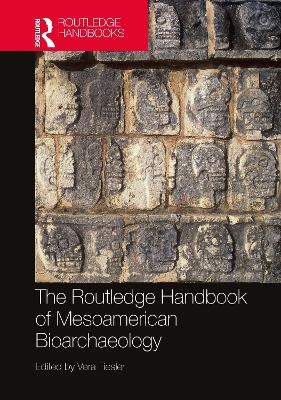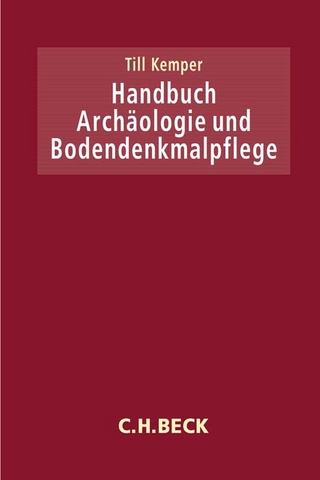
The Routledge Handbook of Mesoamerican Bioarchaeology
Routledge (Verlag)
978-1-032-26654-1 (ISBN)
This handbook provides systematic bioarchaeological coverage of skeletal research in the ancient Mesoamericas. It offers an integrated collection of engrained, bioculturally embedded explorations of relevant and timely topics, such as population shifts, lifestyles, body concepts, beauty, gender, health, foodways, social inequality, and violence. The additional treatment of new methodologies, local cultural settings, and theoretic frames rounds out the scope of this handbook. The selection of 36 chapter contributions invites readers to engage with the human condition in ancient and not-so-ancient Mesoamerica and beyond.
The Routledge Handbook of Mesoamerican Bioarchaeology is addressed to an audience of Mesoamericanists, students, and researchers in bioarchaeology and related fields. It serves as a comprehensive reference for courses on Mesoamerica, bioarchaeology, and Native American studies.
Vera Tiesler is Research Professor at the Mexican Universidad Autónoma de Yucatán, in Mérida, where she heads the Laboratory of Bioarchaeology. She received her BA in art history from Tulane University, an MA in archaeology at the Mexican Escuela Nacional de Antropología e Historia (ENAH), and a PhD in anthropology at the National University of Mexico (UNAM), with five accredited years of medical school (MHH, Hannover, Germany, and IPN, Mexico). Tiesler’s academic interest lies in illuminating the human condition of the ancient Maya and of past society in general.
INTRODUCTION
Vera Tiesler
Part I: FRAMING MESOAMERICAN BIOARCHAEOLOGY
1.1. The Early Days of Mesoamerican Osteology
Andrew K. Scherer
1.2. Management and Conservation of Human Remains From Mesoamerica: Ethical, Legal, and Technical Recommendations
Maria del Carmen Lerma Gómez and Juan Manuel Argüelles San Milán
1.3. The Preceramic Skeletal Record of Mexico and Central America
James C. Chatters, Joaquín Arroyo-Cabrales, and Pilar Luna-Erreguerena
1.4. North of Mesoamerica: Bioarchaeology of the Northwest, North-Central, and Northeast
Patricia Olga Hernández Espinoza and James T. Watson
1.5. Bioarchaeological Studies in the Southern Periphery of Mesoamerica
Shintaro Suzuki
Part II: ACROSS THE HUMAN LANDSCAPES OF PRE-COLUMBIAN MESOAMERICA
2.1. The Bioarchaeology of Preclassic Mesoamerica and the Advent of Statehood
Mónica Rodríguez Pérez
2.2. Bioarchaeology of Oaxaca: Major Developments in the Study of 3500 years of Mortuary Practice in Southern Mexico
Ricardo Higelin Ponce de León and Guy David Hepp
2.3. Maya Bioarchaeology
Andrew K. Scherer and Joshua T. Schnell
2.4. The People of the Southern Central Region of Veracruz
Carlos Serrano Sánchez and Mireya Montiel Mendoza
2.5. The Bioarchaeology of the Central Highlands of Mesoamerica From the Early Classic Period Through the Toltec Period
Emily J. Kate and Meggan Bullock
2.6. The Heartland of the Empire: Studying the Aztecs
Ximena Chávez Balderas, Diana K. Moreiras Reynaga, and Diana Bustos Ríos
Part III: THE BIOARCHAEOLOGY OF CITIES, NEIGHBORHOODS, AND COMMUNITIES
3.1. The Inhabitants of Monte Albán: A Bioarchaeological Approach
Lourdes Márquez Morfín and Aurora Marcela Pérez-Flórez
3.2. The Multiethnic Population of a Teotihuacan Neighborhood Center: Bioarchaeological, Archaeometric, and Ancient DNA Analyses
Linda R. Manzanilla-Naim
3.3. The Community of Xcambó, a Classic-Period Maya Port in the Yucatan Peninsula
Thelma Sierra Sosa, Allan Ortega-Muñoz, and Andrea Cucina
3.4. Bioarchaeology in Copán, Honduras: Spearheading Maya Bioarchaeology
Shintaro Suzuki and T. Douglas Price
Part IV: THE BODY AS A CULTURAL CONSTRUCT
4.1. The Bioarchaeology of Permanent Body Modifications in Mesoamerica
Vera Tiesler
4.2. Royal Bodies: The Life Histories of Janaab’ Pakal and The "Red Queen" of Palenque, Chiapas, Mexico
Erik Velásquez García and Vera Tiesler
4.3. Archaeothanatology: A Body-Anchored Approach to Mesoamerican Mortuary Analyses
Grégory Pereira and Hemmamuthé Goudiaby
4.4. The Bioarchaeology of Ritualized Violence and Posthumous Treatments of the Human Body in Mesoamerica
Judith Ruiz González and Vera Tiesler
Part V: LIFE STYLE, DIET, AND HEALTH
5.1. Mesoamerican Paleopathology: A Bioarchaeological Approach to Diseases From the Past
Raúl López Pérez
5.2. Living Conditions, Gender, and Stature
Marie Elaine Danforth, Jaime Thomas, and Peter Mercier
5.3. Geographic Variation in Mesoamerican Paleodiets: A Review of Recent Stable Carbon and Nitrogen Isotopic Analyses
Victoria S. R. Izzo, Lori E. Wright, and Alex Canterbury
Part VI: POPULATION AND MOBILITY
6.1. Population Continuity and Mobility Across Mesoamerica
Cathy Willermet, Corey S. Ragsdale, and Heather J.H. Edgar
6.2. Baseline Strontium Isotope Ratios in Mesoamerica
T. Douglas Price and Carolyn Freiwald
6.3. The Paleo-DNA of Ancient Mesoamerican Peoples
Víctor Acuña Alonzo and Miguel Angel Contreras Sieck
6.4. Population Structure, Fertility, and Growth
Allan Ortega Muñoz and Patricia Olga Hernández-Espinoza
6.5. The Craniometry of Mesoamerican Population Distances
Jorge A. Gómez-Valdés
Part VII: BREAKING NEW GROUNDS IN METHODOLOGY
7.1. 3D Digitization and Analysis of Human Skeletal Remains for Mesoamerican Bioarchaeology
Gabriel Wrobel
7.2. Methods in Bioarchaeology: What’s New in Profiling an Individual Inside and Out
Carolyn Freiwald, Jonathan Belanich, and Asta Rand
7.3. Histomorphology of Un-Decalcified Bone in Mesoamerican Bioarchaeology
Corey Maggiano and Isabel Maggiano
7.4. The Phenomenon of Mummification in Ancient Mexico
Josefina Mansilla Lory and Ilán S. Leboreiro Reyna
Part VIII: THE BIOARCHAEOLOGY OF THE THRESHOLDS OF MODERNITY: LEARNING FROM THE PAST TO MEET TODAY'S CHALLENGES
8.1. The Bioarchaeology of Colonial New Spain
Julie K. Wesp
8.2. The Serdán Brothers: Reconstructing the Mortuary Trajectory of the Three Heroes of the Mexican Revolution
Luisa Mainou Cervantes and Jorge A. Gómez Valdés
8.3. General Trends in Size in Maya Populations of the Yucatan Peninsula From the Preclassic to the 2010s: A Diachronic Perspective From Human EcologyHugo Azcorra, Saul Chay Vela, Oana del Castillo Chávez, and Federico Dickinson Bannack
8.4. Making Research of Human Reference Collections Available to Bioarchaeology and Forensic Anthropology
Julio Roberto Chi Keb, Antinea Menéndez Garmendia, Gabriela Sánchez-Mejorada, and Jorge Gómez-Valdés
| Erscheinungsdatum | 15.06.2022 |
|---|---|
| Zusatzinfo | 45 Tables, black and white; 34 Line drawings, black and white; 88 Halftones, black and white; 122 Illustrations, black and white |
| Verlagsort | London |
| Sprache | englisch |
| Maße | 174 x 246 mm |
| Gewicht | 453 g |
| Themenwelt | Geisteswissenschaften ► Archäologie |
| Sozialwissenschaften ► Ethnologie | |
| Sozialwissenschaften ► Soziologie | |
| ISBN-10 | 1-032-26654-6 / 1032266546 |
| ISBN-13 | 978-1-032-26654-1 / 9781032266541 |
| Zustand | Neuware |
| Haben Sie eine Frage zum Produkt? |
aus dem Bereich


